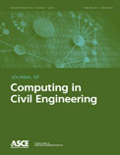
JOURNAL OF COMPUTING IN CIVIL ENGINEERING
Scope & Guideline
Advancing the Future of Civil Engineering Through Computing.
Introduction
Aims and Scopes
- Machine Learning and Artificial Intelligence Applications:
Research related to the use of machine learning and AI in various civil engineering domains, such as construction project management, structural health monitoring, and predictive modeling. - Digital Twin and BIM Technologies:
Exploration of digital twin technologies and Building Information Modeling (BIM) for enhanced project visualization, management, and collaboration in civil engineering. - Robotics and Automation in Construction:
Studies focusing on the implementation of robotic systems and automation technologies to improve efficiency, safety, and precision in construction processes. - Data-Driven Decision Making:
Research emphasizing the use of big data analytics, simulation, and modeling to support informed decision-making in civil engineering practices. - Sustainability and Environmental Impact Assessments:
Investigations into sustainable practices, environmental assessments, and the impact of civil engineering projects on ecosystems and communities. - Smart Infrastructure and IoT Integration:
Studies on the integration of Internet of Things (IoT) technologies into infrastructure projects for real-time monitoring, maintenance, and management.
Trending and Emerging
- Advanced Machine Learning Techniques:
There is a notable increase in the application of advanced machine learning techniques, including deep learning and neural networks, for predictive analytics and problem-solving in civil engineering. - Integration of Robotics and AI in Construction:
The trend towards robotics and AI integration in construction processes is rising, focusing on autonomous systems, robotic inspections, and human-robot collaboration. - Resilience and Adaptation Strategies in Infrastructure:
Emerging research themes focus on resilience and adaptation strategies to enhance infrastructure's ability to withstand environmental challenges and disasters. - Interdisciplinary Approaches to Civil Engineering Problems:
An emerging trend is the adoption of interdisciplinary approaches that combine insights from computer science, engineering, environmental science, and social sciences to tackle complex civil engineering issues. - Real-Time Data Utilization and Smart Monitoring Systems:
Research is increasingly focusing on real-time data utilization through IoT devices and smart monitoring systems for proactive management of civil infrastructure.
Declining or Waning
- Traditional Structural Analysis Methods:
Research focusing on conventional structural analysis techniques is becoming less prevalent, as more innovative computational methods and tools gain traction. - Basic CAD Techniques:
The emphasis on traditional Computer-Aided Design (CAD) techniques is waning, as more sophisticated modeling approaches like BIM and parametric design take precedence. - Manual Inspection and Monitoring Techniques:
Studies involving manual inspection methods are decreasing, with a shift toward automated and sensor-based monitoring systems for infrastructure assessment. - Static Environmental Impact Assessments:
Traditional static assessments are being replaced by dynamic, real-time monitoring approaches that leverage digital technologies and data analytics.
Similar Journals

Journal of Information Technology in Construction
Driving Progress in Construction Through Rigorous ResearchThe Journal of Information Technology in Construction is a premier open-access journal dedicated to advancing knowledge in the intersection of information technology and construction practices. Established in 1996, this journal has emerged as a vital resource for researchers, professionals, and students in the fields of Building and Construction, Civil and Structural Engineering, and Computer Science Applications. Published by the INT COUNCIL RESEARCH & INNOVATION BUILDING & CONSTRUCTION, this journal's rigorous peer-reviewed content is designed to foster innovation and enhance the application of technological solutions within the construction sector. With a commendable reputation, the journal has secured Q1 ranking in Building and Construction and features in the top quartiles in related disciplines, ensuring its impact and relevance within academic and industrial communities. Conveniently accessible, the journal showcases high-quality research that influences both theoretical and practical aspects of construction technology, thereby contributing significantly to the field. Based in Sweden, the Journal of Information Technology in Construction stands as a crucial platform for disseminating insights that drive progress in this dynamic and evolving domain.

Engineering Journal-Thailand
Advancing engineering knowledge, one article at a time.Engineering Journal-Thailand, published by Chulalongkorn University, Faculty of Engineering, is a prominent academic journal dedicated to advancing knowledge and research in the diverse field of engineering. With an ISSN of 0125-8281 and an unwavering commitment to quality, the journal has established a substantial presence in the academic community since its inception in 2009. As of 2023, it is ranked in the Q3 category for Engineering (miscellaneous) and has achieved a Scopus rank of 137 out of 307, placing it in the 55th percentile of general engineering journals. Although it operates without open access, its impact within the engineering domain is significant, providing a vital platform for researchers, professionals, and students to disseminate their findings and engage with contemporary engineering challenges. The journal serves as a vital resource for those seeking to stay at the forefront of engineering innovation and contributes to the global discourse by bridging local insights with international perspectives.
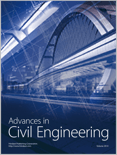
Advances in Civil Engineering
Transforming Ideas into Engineering ExcellenceAdvances in Civil Engineering is a leading peer-reviewed journal published by HINDAWI LTD, dedicated to advancing knowledge and innovation in the field of civil and structural engineering. Holding an esteemed Q2 ranking in the 2023 category for Civil and Structural Engineering, this journal serves as a vital platform for disseminating cutting-edge research and practical applications that address contemporary challenges in infrastructure development, sustainable design, and material science. Launched in 2008 and operating as an Open Access journal since 2009, it promotes the free exchange of ideas by ensuring that all articles are accessible to researchers, professionals, and students globally. The journal is also indexed in Scopus, ranking at #142 out of 379 in its category, situating it within the 62nd percentile of its peers. With a focus on interdisciplinary collaboration and innovative solutions, Advances in Civil Engineering contributes significantly to the ongoing evolution of engineering practices and education, making it an essential resource for anyone involved in or studying the ever-evolving field of civil engineering.

Gradevinar
Advancing Civil Engineering Knowledge, Open to AllGradevinar, published by the Croatian Society of Civil Engineers-HSGI, is a leading Open Access journal in the field of Civil and Structural Engineering, with a significant history that dates back to its inception in 1980. This journal, with the ISSN 0350-2465 and E-ISSN 1333-9095, has established itself as a vital platform for disseminating innovative research and practical developments in civil engineering, particularly since it became Open Access in 2000, facilitating unrestricted access to its wealth of knowledge. As of 2023, Gradevinar is ranked in the third quartile (Q3) of Scopus’s Civil and Structural Engineering category, demonstrating its growing influence and relevance in the academic community, with a current ranking of #255 out of 379 journals in the field. Researchers, professionals, and students benefit from this journal's commitment to high-quality content that reflects the latest advancements and best practices in civil engineering, contributing to both technical proficiency and sustainable development in infrastructure projects across Croatia and beyond.

JOURNAL OF INFORMATION SCIENCE AND ENGINEERING
Connecting Researchers in the Evolving World of Information.JOURNAL OF INFORMATION SCIENCE AND ENGINEERING, published by the Institute of Information Science in Taiwan, is a pivotal platform for the dissemination of innovative research in the multidisciplinary fields of information science and engineering. Established in 1993, the journal primarily focuses on areas such as library and information sciences, human-computer interaction, hardware and architecture, as well as computational theory and software development. Despite holding a current Q4 ranking in several categories, the journal demonstrates significant potential for growth, particularly in computation and software systems, as evidenced by its Scopus rankings and percentiles. Researchers, professionals, and students will find this journal to be an invaluable resource to stay abreast of evolving theories and technologies in information science. The journal is accessible through traditional subscription models, fostering a broad academic outreach. It serves to enhance knowledge-sharing and collaboration within this dynamic and ever-evolving field.
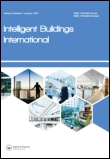
Intelligent Buildings International
Fostering Interdisciplinary Insights for Modern ConstructionIntelligent Buildings International, published by Taylor & Francis Ltd, is a premier journal dedicated to advancing knowledge in the interdisciplinary domains of building construction, civil engineering, computer science applications, and planning. Since its inception in 2009, this journal has become a vital resource for researchers, professionals, and students, offering a platform for high-quality scholarly articles that explore innovative strategies and technologies in intelligent building design and efficiencies. With its significant impact factor reflected in its Q2 and Q3 quartile rankings across various related fields, and strong Scopus rankings placing it among the top journals in Geography, Building, and Civil Engineering, Intelligent Buildings International stands out for its commitment to fostering research that enhances the sustainability and functionality of contemporary architectural practices. Readers can access a wealth of articles that illuminate the complexities of smart building technologies and their implications for future construction practices, making it an essential addition to any academic library.
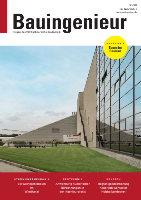
Bauingenieur
Shaping the Future of Building and Construction EngineeringBauingenieur, an established journal in the field of Building and Construction and Civil and Structural Engineering, has been a significant platform for scholarly discourse since its inception in 1969. Published by VDI FACHMEDIEN GMBH & CO KG UNTERNEHMEN FACHINFORMATIONEN in Germany, this journal, available in both print (ISSN: 0005-6650) and electronic formats (E-ISSN: 1436-4867), serves as a vital resource for researchers, professionals, and students dedicated to advancing knowledge and practice in engineering. Although currently without open access options, Bauingenieur aspires to contribute to the academic community by presenting cutting-edge research, case studies, and technical reviews within the realms of construction and civil engineering. As evidenced by its categorizations in the 2023 Scopus rankings, where it has a Q4 designation in both relevant categories, it provides an essential resource for understanding current trends and challenges in the industry. The journal welcomes contributions that push the boundaries of knowledge and foster innovative solutions in the built environment.
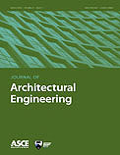
Journal of Architectural Engineering
Pioneering Research in Architectural Engineering ExcellenceThe Journal of Architectural Engineering, published by the ASCE (American Society of Civil Engineers), stands as a pivotal resource in the interdisciplinary fields of architecture and engineering. With an ISSN of 1076-0431 and E-ISSN 1943-5568, this journal has garnered a notable reputation since its inception in 1995, currently converging towards 2024. Boasting a Q1 ranking in Architecture and Visual Arts and Performing Arts, alongside respectable Q3 rankings in Building and Construction and Civil and Structural Engineering, the journal places itself in the elite class of scholarly publications, evidenced by its impressive Scopus rankings. Its commitment to providing cutting-edge research ensures comprehensive coverage across various aspects of architectural engineering, facilitating robust interdisciplinary dialogues. Although the journal operates under a traditional access model, its impact on the academic community remains profound, making it an essential platform for researchers, professionals, and students who seek to push the boundaries of knowledge in their respective fields. This journal not only aims to stimulate innovative ideas but also fosters a collaborative environment for advancing sustainable architectural practices in a rapidly evolving built environment.

CANADIAN JOURNAL OF CIVIL ENGINEERING
Innovative Insights for Sustainable InfrastructureCanadian Journal of Civil Engineering, published by Canadian Science Publishing, serves as a premier platform for the dissemination of innovative research and development in the fields of civil and structural engineering, as well as environmental science. Established in 1971, this journal maintains a robust reputation, achieving a Q3 ranking in both civil engineering and general environmental science categories as of 2023. While it does not currently offer open access, the journal is accessible to a wide audience of researchers, professionals, and students who are keen to stay abreast of the latest advancements in civil engineering practices. With a significant number of yearly publications and a committed editorial board, the Canadian Journal of Civil Engineering contributes to the foundational knowledge and practical applications in the engineering community, thereby playing a critical role in addressing contemporary challenges in civil infrastructure and environmental sustainability.
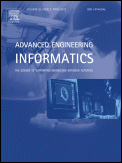
ADVANCED ENGINEERING INFORMATICS
Empowering Innovation Through Open Access ResearchADVANCED ENGINEERING INFORMATICS is a prestigious journal published by Elsevier Science Ltd, dedicated to the interdisciplinary fields of Artificial Intelligence and Information Systems. Established in 2002, this journal serves as a vital platform for researchers and practitioners to disseminate groundbreaking insights and innovations that shape the future of engineering and technological integration. With an impressive impact factor and ranked in the Q1 category for both Artificial Intelligence and Information Systems in 2023, it holds a prominent position, with Scopus rankings placing it in the 92nd percentile among 394 journals in Computer Science Information Systems and the 87th percentile among 350 journals in Computer Science Artificial Intelligence. ADVANCED ENGINEERING INFORMATICS embraces an Open Access model, ensuring that cutting-edge research is accessible to a global audience, fostering collaboration and development across academic and professional circles. The journal is committed to advancing knowledge and influencing practice, paving the way for the next generation of technologies that enhance engineering informatics.